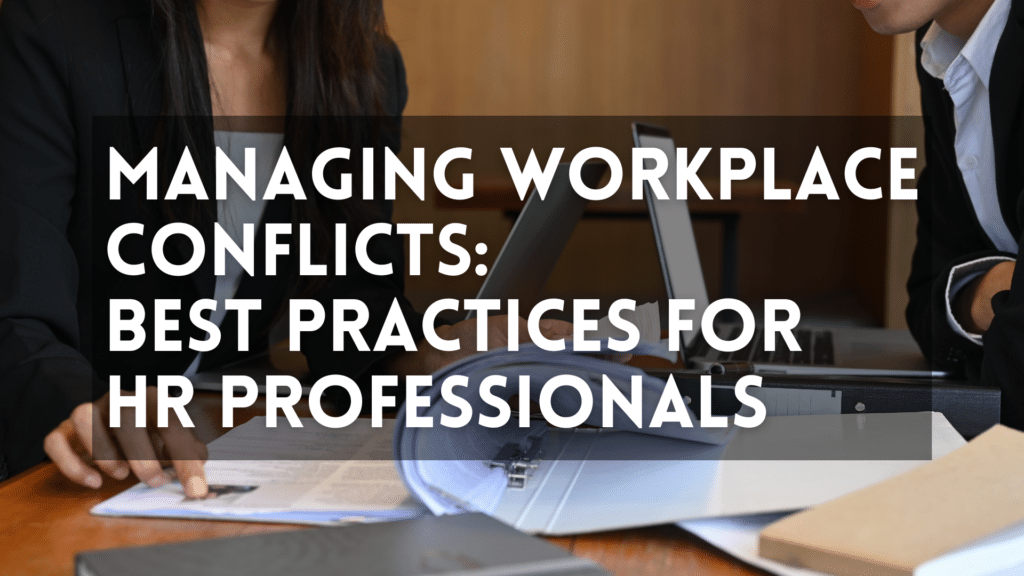
Conflicts are inevitable.
This is especially true in any workplace, as employees are bound to have disagreements from time to time. Workplace conflicts can arise from a variety of sources, including but not limited to differences in personality, misunderstandings over wants and dos, or even tangles in personal relationships.
According to CPP Inc., the publisher of the Myers-Briggs Type Indication Assessment, 85% of employees in the United States admitted to having experienced some form of conflict at work.

Many people believe that some level of conflict can be healthy for organizations. Sure, but too much of it can lead to a toxic culture, decreased productivity, and disturbed work harmony, especially when left unaddressed or mishandled.
“It’s an enormous drain on an organization,” says Joseph Grenny, co-founder of VitalSmarts and co-author of Crucial Conversations: Tools for Talking When Stakes are High, as quoted in a Society for Human Resource Management article.
Therefore, managing workplace conflicts is no doubt a must-have, critical skill for HR professionals. They play a vital role in mediating and resolving disputes that can either jeopardize or save an organization from a lot of turmoil. As persons tasked with managing and retaining employees, it is important that they are equipped with the right strategies and techniques to bring conflicts to an end in a timely and effective manner.
The author thus compiled some steps on how to resolve workplace conflicts, coupled with insights from HR experts as quoted from various sources.
1. Address the conflict ASAP
As soon as conflict arises, HR should intervene immediately.
According to the Society of Human Resources Management, waiting is not an option in case there is a conflict, be it just little disagreements or major blow-ups, as “increased productivity and engagement are correlated with the shortness of time between identifying a problem and discussing it.”

2. Communicate
In order to deal with the conflict at work, it is best for HR to understand the root cause of the problem by conducting a proper and unbiased investigation.
For Cloudreach HR Professional Evan Lassiter – also a member of the Forbes Human Resources Council – it is a must to sit with the parties in question. According to Forbes’ 14 Ways HR Professionals Can Solve Workplace Conflict Efficiently, HR professionals should keep an open mind and hear each version of what is happening.
Nonetheless, when mediating between employees, HRs should set ground rules for the meeting where they can express their grievances freely without fear of repercussions but still with utmost respect towards each other.
3. Encourage mutual resolution
Sure, HR can feel overwhelmed thinking about solutions. It is important to get all sides of the story, and once the employee feels at ease with the fact that someone is listening to their grievances, HR should encourage them to think of possible solutions.
It is important to note that conflict resolution is not always going to be a one-and-done process. HR should note that the problem will only be addressed once the parties find common ground, and in that case, they will be able to suggest positive rather than punitive, vindictive actions.
For Sherry Martin of Denver Public Schools, the role of HR is to facilitate with the employees in conflict an interest-based resolution that focuses on the problem and not people.
“HR should meet with each employee separately to understand the conflict, find out their needs and wants, and what each is willing to do to support a solution. A successful resolution happens when the employees in conflict come up with their own solutions,” Martin was quoted to have said in a Forbes’ story.
4. Monitor progress

Human resource management is not just a job. HR professionals must show that they genuinely care and that they truly want a positive outcome amidst all the conflicts.
HR professionals must stay up to date on the progress of the parties. According to BambooHR, an organization training and development solution, these mechanisms can include employees submitting progress reports, HR holding follow-up meetings with managers, and reviewing day-to-day improvements in employee interactions.
5. Prevent the same problem from happening again
It is not sufficient that the conflict was resolved. HR professionals should prevent the same issue from occurring in the future.
“Many HR professionals are trained in conflict resolution but once the employees involved have been addressed, either separately or together, the topic is dropped. In many cases, things linger so it’s good to check in with those involved to see if progress has been made and if additional support and follow-up is needed.” – Brooke Peterson of Skyfii was quoted to have said in a Forbes’ article.
While it is impossible to completely prevent conflict in the workplace, HR professionals must be equipped with conflict resolution strategies that will help establish and maintain a healthy, effective, and positive working environment.
References:
Council, F. H. R. (2018, April 10). 14 Ways HR Professionals Can solve workplace Conflict Efficiently. Forbes.
Ardila, C. (2023, December 8). 9 Tips for HR to Manage Conflict in the Workplace.
BizLibrary. https://bizlibrary.com/blog/leadership/hr-manage-workplace-conflict/
De Luca, R. (n.d.). How to handle conflict resolution in the workplace like a pro. https://www.bamboohr.com/blog/conflict-resolution-in-workplace
Kuligowski, K. (2023, November 20). Workplace conflicts? 5 tips to Improve communication. Business News Daily. https://www.businessnewsdaily.com/8766-resolving-workplace-conflicts.html
JOB STORY – LAHAT GROUP – 라핫그룹

